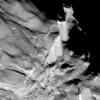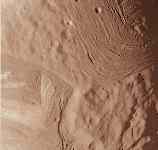Uranus V
Miranda (“mi RAN duh”) is the eleventh of Uranus’s known satellites. Miranda is the innermost of Uranus’ large moons.
orbit: 129,850 km from Uranus
diameter: 472 km
mass: 6.3e19 kg
Miranda is a daughter of the magician Prospero in Shakespeare’s The Tempest.
Discovered by Kuiper in 1948.
Voyager 2 was forced to fly close to Uranus in order to get the boost it needed to go on to Neptune and due to the orientation of the whole system at almost right angles to the ecliptic only Miranda was approached closely. Before Voyager, of course, little was known about Miranda and as it is not the largest or in any other way remarkable, it probably would not have been chosen as the prime target at Uranus. Voyager’s good luck held up, however, as Miranda turned out to be by far the most interesting.

Miranda is about half water ice and half rocky material.
Miranda’s surface is all mixed up with heavily cratered terrain intermixed with weird grooves, valleys and cliffs (one over 5 kilometers high; left).

At first, Voyager 2’s images of Miranda were a mystery. Everyone had expected that Uranus’ moons would show very little history of internal activity (like Callisto). Explaining the bizarre hitherto unknown terrain proved quite an embarrassment to those who had to do it on live TV. Their usual impressive and esoteric technical jargon gave out and they had to resort to using such terms as “chevron” (right), “race track”, and “layer cake” to describe Miranda’s unique features.
It was initially thought that Miranda had been completely shattered and reassembled several times in its history, each time burying some parts of the original surface and exposing some of the interior. Now, however, a more mundane explanation involving the upwelling of partially melted ices seems to be in favor.
Voyager 2 passed so close to Miranda and the light levels are so low there (almost 3 billion km from the Sun) that special measures had to be employed to avoid smearing the images. This was accomplished by rotating the entire spacecraft while the camera’s shutter was open to compensate for its motion. The resulting images have the best resolution of the entire mission.
It is actually possible to see Uranus’s 4 largest moons with an amateur telescope, but Miranda is a real challenge. Perhaps with a very dark sky and a telescope with an 18 inch (50 cm) aperture or more it might be possible.
More about Miranda
- more images

Open Issues
- The upwelling and shattering explanations for Miranda’s bizarre appearance are really just speculation. Much more evidence is needed to provide a satisfactory explanation.
- There are no more missions planned to Uranus and Neptune. When will we next visit to this peculiar world? The data from Voyager 2 may be all we have for a very long time.
